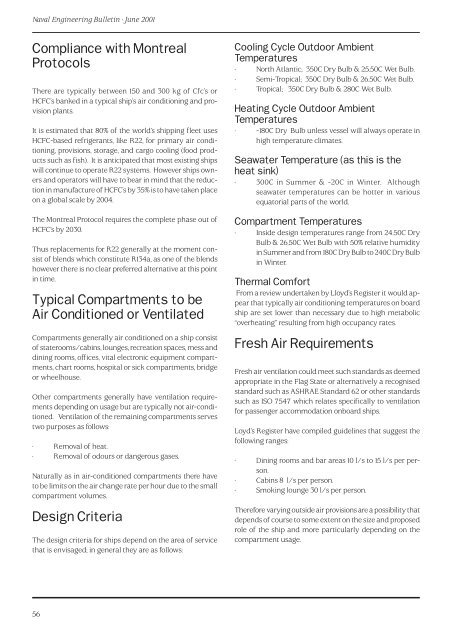Engineering - Royal Australian Navy
Engineering - Royal Australian Navy
Engineering - Royal Australian Navy
Create successful ePaper yourself
Turn your PDF publications into a flip-book with our unique Google optimized e-Paper software.
Naval <strong>Engineering</strong> Bulletin • June 2001<br />
Compliance with Montreal<br />
Protocols<br />
There are typically between 150 and 300 kg of Cfc’s or<br />
HCFC’s banked in a typical ship’s air conditioning and provision<br />
plants.<br />
It is estimated that 80% of the world’s shipping fleet uses<br />
HCFC-based refrigerants, like R22, for primary air conditioning,<br />
provisions, storage, and cargo cooling (food products<br />
such as fish). It is anticipated that most existing ships<br />
will continue to operate R22 systems. However ships owners<br />
and operators will have to bear in mind that the reduction<br />
in manufacture of HCFC’s by 35% is to have taken place<br />
on a global scale by 2004.<br />
The Montreal Protocol requires the complete phase out of<br />
HCFC’s by 2030.<br />
Thus replacements for R22 generally at the moment consist<br />
of blends which constitute R134a, as one of the blends<br />
however there is no clear preferred alternative at this point<br />
in time.<br />
Typical Compartments to be<br />
Air Conditioned or Ventilated<br />
Compartments generally air conditioned on a ship consist<br />
of staterooms/cabins, lounges, recreation spaces, mess and<br />
dining rooms, offices, vital electronic equipment compartments,<br />
chart rooms, hospital or sick compartments, bridge<br />
or wheelhouse.<br />
Other compartments generally have ventilation requirements<br />
depending on usage but are typically not air-conditioned.<br />
Ventilation of the remaining compartments serves<br />
two purposes as follows:<br />
• Removal of heat.<br />
• Removal of odours or dangerous gases.<br />
Naturally as in air-conditioned compartments there have<br />
to be limits on the air change rate per hour due to the small<br />
compartment volumes.<br />
Design Criteria<br />
The design criteria for ships depend on the area of service<br />
that is envisaged; in general they are as follows:<br />
Cooling Cycle Outdoor Ambient<br />
Temperatures<br />
• North Atlantic; 350C Dry Bulb & 25.50C Wet Bulb.<br />
• Semi-Tropical; 350C Dry Bulb & 26.50C Wet Bulb.<br />
• Tropical; 350C Dry Bulb & 280C Wet Bulb.<br />
Heating Cycle Outdoor Ambient<br />
Temperatures<br />
• -180C Dry Bulb unless vessel will always operate in<br />
high temperature climates.<br />
Seawater Temperature (as this is the<br />
heat sink)<br />
• 300C in Summer & -20C in Winter. Although<br />
seawater temperatures can be hotter in various<br />
equatorial parts of the world.<br />
Compartment Temperatures<br />
• Inside design temperatures range from 24.50C Dry<br />
Bulb & 26.50C Wet Bulb with 50% relative humidity<br />
in Summer and from 180C Dry Bulb to 240C Dry Bulb<br />
in Winter.<br />
Thermal Comfort<br />
From a review undertaken by Lloyd’s Register it would appear<br />
that typically air conditioning temperatures on board<br />
ship are set lower than necessary due to high metabolic<br />
“overheating” resulting from high occupancy rates.<br />
Fresh Air Requirements<br />
Fresh air ventilation could meet such standards as deemed<br />
appropriate in the Flag State or alternatively a recognised<br />
standard such as ASHRAE Standard 62 or other standards<br />
such as ISO 7547 which relates specifically to ventilation<br />
for passenger accommodation onboard ships.<br />
Loyd’s Register have compiled guidelines that suggest the<br />
following ranges:<br />
• Dining rooms and bar areas 10 l/s to 15 l/s per person.<br />
• Cabins 8 l/s per person.<br />
• Smoking lounge 30 l/s per person.<br />
Therefore varying outside air provisions are a possibility that<br />
depends of course to some extent on the size and proposed<br />
role of the ship and more particularly depending on the<br />
compartment usage.<br />
56
















